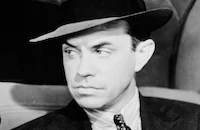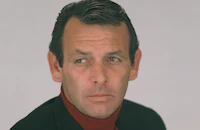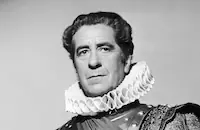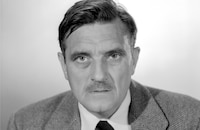Chief Crazy Horse
Brief Synopsis
Cast & Crew
George Sherman
Victor Mature
Suzan Ball
John Lund
Ray Danton
Keith Larsen
Film Details
Technical Specs

Synopsis
Major Twist, formerly of the U.S. Cavalry, returns to the Big Horn, once the home of the Lakota Sioux and their most important leader, Chief Crazy Horse. The land, now barren, calls forth a flood of memories for Twist. He tells a story that Crazy Horse related to him of a summer day in 1854, when Conquering Bear, chief of the Great Sioux Nation, returns wounded from a battle with the white man. Before dying, Conquering Bear prophesies that a great warrior will rise up and unite all the tribes of the Lakota to victory against the whites, but that he will die at the hand of a Lakota. Crazy Horse, so named because a wild horse ran through his village on the day of his birth, envisions a warrior wearing a warbonnet of red hawk feathers and riding a golden stallion out of a thunderbolt. In the years that follow, the white man breaks treaties and pushes the Sioux tribes further back. At Laramie, the Sioux Nation is promised that no more forts or roads cutting through the Dakotas will be built and that the sacred Black Hills will be left alone. Many of the Sioux tribes agree to move to reservations in exchange for food and goods, but the proud Lakotas are among those who cling to ancient ways. Crazy Horse, attacked by three Shoshone, who have long been enemies of the Lakota, kills them and recovers feathers of the red-beaked hawk from one. Little Big Man, his cousin, taunts Crazy Horse saying that he will use the three captured Shoshone horses as presents for the hand in marriage of Little Faun, whom Little Big Man also wants for a wife. Meanwhile, Twist, wounded by the Shoshone, falls off his horse into a creek and Little Faun rescues him. As Little Faun has become a woman, her father, Spotted Tail, says she will be known by a woman's name, Black Shawl. Spotted Tail rejects the presents offered by a number of warriors, including Crazy Horse, but Twist, in gratitude to Little Faun, who, he knows, loves Crazy Horse, gives Crazy Horse trade goods to add to his offerings. After Spotted Tail gives his daughter to Crazy Horse, Little Big Man insults Crazy Horse and they battle. Crazy Horse is victorious and Spotted Tail then sends Little Big Man away. Little Big Man follows Twist to Fort Laramie. He gets into a scuffle with a bigoted salesman at the Mantz Brothers Trading Company, and after Jeff Mantz discovers that Little Big Man carries gold, he and his brother Caleb offer him a job. The Mantz brothers ask Commissioner Aaron Cartwright permission to have the Black Hills surveyed with the aim to create a new source of wealth for the American people. When Cartwright refuses, saying such an action would lead to war, Jeff Mantz says disdainfully that Cartwright is part Indian himself. The commissioner's son, Lieutenant Colin Cartwright, acknowledges that his grandmother was an Indian and that they are proud of their heritage. In secret, the Mantz brothers pan for gold in the Black Hills with Little Big Man as a guide and lookout. After they find gold and decide to stake claims, the Mantz brothers kill a neighboring Indian family. When Little Big Man turns away in horror, Jeff Mantz says he will see more bloodshed until the country is "civilized." News of the Mantz's mining claim leads to a rush of prospectors into the Black Hills. When the Sioux Nation takes up arms in a new war, the government has no alternative but to protect the miners and build Fort Phil Kearny deeper into Sioux land. The Sioux leaders argue about how to respond, and Crazy Horse says that they should conduct their campaigns in a military fashion like the cavalry. With Crazy Horse as leader, the Sioux trick troops led by the pompous Captain William Fetterman into a trap. Now respected in war, the Sioux can go to the fort to talk of peace. Commissioner Cartwright promises that the fort will be destroyed if the Sioux agree to move into a reservation. When some of the Indians are about to consent, Crazy Horse berates them for their short memory of the white man's betrayal. Calling the land sacred, Crazy Horse promises to fight and die for it. The commissioner sadly gives General George Crook permission to bring the Sioux back. Twist rides to warn the Sioux and is wounded and brought to the lodges along with his golden horse, which Crazy Horse believes is the horse from his vision. Warning that Crook has twice the number of men that Crazy Horse has, Twist tries to get Crazy Horse to surrender, but the Lakota warrior argues that Indians have gotten weak from eating the white man's food and from his "coughing sickness," and declares he would rather that his newborn daughter and her sons be dead if they can't live the life of their forefathers. Twist says he has no choice but to fight against him. While trying to leave, Twist falls off his horse because of his injury, and the golden horse walks to Crazy Horse. Black Shawl tells Twist she will care for him. At a ceremony, Crazy Horse is made leader of his people, and he wears the red hawk feathers. When troops cross the river marking Lakota territory, the Lakota attack and kill the Shoshone scouts first, then take the supply wagons and draw the soldiers into a battle so that they will use up their ammunition. During the battle, Lieutenant Cartwright is killed. Crazy Horse sends a captured soldier back with a message to the general warning that any white man who comes into their land will be killed. When Commissioner Cartwright is informed about his son's death, he goes to the Mantz brothers' office and shoots them before killing himself. Upon his return to the village, Crazy Horse finds that his daughter has died from the coughing sickness. At her grave, Black Shawl tells him that General George Armstrong Custer is coming to Big Horn with many soldiers. Crazy Horse devises a plan to defeat Custer by having the Sioux attack from the forest and the Cheyenne from the river, and Custer is routed. After the battle, the Indians separate and one-by-one are defeated and put into reservations. Crazy Horse and some of his young followers hold out deep in the Badlands, but when Black Shawl becomes deathly ill from the coughing sickness, Crazy Horse brings her to the fort, and with the white man's medicine, she almost completely revives by the spring. In the summer, Crazy Horse asks General Crook, who respects him, if they could return to hunt buffalo, saying buffalo provides food, skins for clothing, bone for arrows, hair for ropes, and shoes, and that they are no longer Lakota without the buffalo, but instead are nameless and dead. General Crook agrees to let them go if they will hunt without guns, using traditional weapons, and if they will return before the next snow. Little Big Man, however, taunts Crazy Horse, then stabs him in the back with his bayonet. Seeing the bloodied blade, Little Big Man throws it down and runs out of the fort. Black Shawl and Twist find that Crazy Horse has died, and Twist relates that the prophesy has been fulfilled.

Director
George Sherman
Cast

Victor Mature
Suzan Ball

John Lund

Ray Danton

Keith Larsen

Paul Guilfoyle

David Janssen

Robert Warwick

James Millican

Morris Ankrum
Donald Randolph
Robert F. Simon

James Westerfield
Stuart Randall
Pat Hogan

Dennis Weaver
John Peters
Henry Wills
Willie Hunter Jr.
Charles Horvath

Bill Williams
Robert St. Angelo
Reg Parton
Emile Avery

David Miller
Crew
Gerald Drayson Adams
Gerald Drayson Adams
William Alland
Tom Andre
Phil Bowles
Robert Boyle
Leslie I. Carey
Al Clark
Franklin Coen
Jack Daniels
Dick Evans
William Fritzsche
Russell A. Gausman
Joseph Gershenson
Leonard Goldstein
Alexander Golitzen
Marshall Green
Ray Jeffers
Corson Jowett
Harold Lipstein
David Miller
Rosemary Odell
Frank Skinner
Joan St. Oegger
Bud Westmore

Film Details
Technical Specs

Quotes
Trivia
Notes
After the opening credits, the following statement appears: "This is a true story, photographed in the Black Hills of the Dakotas, where it actually happened. It is the story of an American, a leader of his people, one of the great generals of all time-Chief Crazy Horse of the Lakota Sioux." The end credits state the following acknowledgment: "We wish to express our appreciation to the Department of the Interior National Park Service for permission to photograph in the Badlands National Monument, South Dakota. This picture was made with the cooperation of the Oglala Sioux tribe of South Dakota." In a pressbook, director George Sherman claimed that the film was "a faithful depiction of Crazy Horse's life." He commented, "All the kids and a good majority of the grown-ups like to see the Red Men emerge victorious. Kids have always made heroes out of their favorite Indian chiefs of history."
According to studio press materials, John Sitting Bull, the 91-year-old son of Sitting Bull and one of only two survivors of the massacre at Little Big Horn, declared Chief Crazy Horse to be "the first motion picture which will recognize that Indian women, like white ones, suffered great anxiety while their men were doing battle." Harrrison's Reports noted that the film was "somewhat different from most stories that deal with a conflict between Indians and whites. This time the Indians are given sympathetic treatment and are depicted as being persecuted by the whites." Motion Picture Herald Prod Digest predicted that the film would do well at the box office, "if the mistreated-Indian theme hasn't reached the point of diminishing returns."
About the subject of the film, Hollywood Reporter commented, "Few Indians in American history command such admiration and respect as Crazy Horse....Unfortunately, neither the performance of Victor Mature, in the title role, nor the screenplay by Franklin Coen and Gerald Drayson Adams, succeeds in getting anything more than a pedestrian concept of the great man on the screen....A foreward says that this is a true story and it is, after a fashion, but it is not a complete or well-rounded presentation of the truth." Other reviews agreed that Mature was miscast in the role.
Daily Variety commented that CinemaScope "makes the stock footage scenes inserted here and there seem poor, particularly as the library scenes do not blow up to CinemaScope size with any clarity." Time surmised that "there were apparently not enough extras left to stage Custer's last stand at Little Big Horn. So, curiously, the picture dispenses with most of it." Studio press materials note that several Sioux tribe members appeared in small roles. Chief Crazy Horse marked the last film for Suzan Ball, who developed cancer as a result of a knee injury suffered on the set of East of Sumatra (for more information, see below). Although her right leg was amputated, she died from cancer in 1955, at the age of twenty-two, after appearing in only seven films. Daily Variety noted, "The doubling-in scenes requiring movement are very good." The film also marked Ray Danton's screen debut and was one of the last of co-producer Leonard Goldstein, who died before the picture's release.

Miscellaneous Notes
Released in United States Spring April 1955
CinemaScope
Released in United States Spring April 1955











